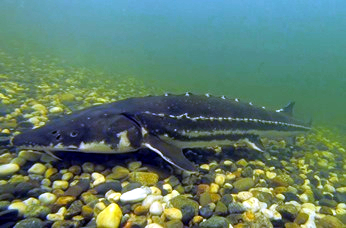Sturgeon Report Card
Q: Why does CDFW require a sturgeon report card?

A: Among the biggest challenges for biologists working to conserve California’s sturgeon population is acquiring data on the fishery. The Sturgeon Fishing Report Card helps biologists track data on catch and release rates, when and where sturgeon are being caught and harvested, and which species of sturgeon are being caught. It sounds like simple information, but it’s incredibly valuable for estimating population size for conservation purposes. Anglers who return the report card are not only fulfilling reporting requirements, but also serving as stewards of the state’s natural resources. Regulations and reporting requirements can be found in California Code of Regulations (CCR), Title 14, section 5.79. Any angler taking sturgeon is required to purchase a Sturgeon Fishing Report Card and to have it in their possession while fishing for sturgeon. Report card information can be submitted online or by mail. Anglers must report even if no sturgeon were caught or if the angler did not go sturgeon fishing. California has populations of both white and green sturgeon. Green sturgeon from the southern population were federally listed as a threatened species in 2006. White sturgeon, and the northern population of green sturgeon, are categorized as a state species of special concern. For more information, please visit wildlife.ca.gov/Conservation/Fishes/Sturgeon.
Deer entanglement
Q: What happened with that buck near Sacramento that had a hammock caught in its antlers? Was the California Department of Fish and Wildlife (CDFW) able to help it?
A: We have good news to share! In December 2020, we posted a photo on social media of an unfortunate situation where a buck had entangled itself in a hammock in Sacramento County. The buck was attracted to the area by people who were regularly feeding it. It is unlawful to feed deer in California for many different reasons—entanglement in human-made objects being one of them. CDFW personnel, with help from Gold Country Wildlife Rescue’s Ben Nuckolls, responded to help the skittish deer in distress. After several attempts, CDFW Environmental Scientist David Mollel successfully darted the buck, removed the antlers (male deer shed and regrow their antlers every year), ear-tagged and released it to nearby suitable habitat. Wildlife officers addressed the feeding issue directly with the homeowners who were feeding it and spoke with the homeowner’s association to solicit cooperation from the community. Months later, a follow-up visit showed that the homeowners removed the food sources and have been much more careful about placement of items that could entrap a deer like volleyball nets, clothesline, tree swings and hammocks. Mr. Nuckolls recently happened upon the buck and is happy to share that it is healthy and growing a beautiful new set of antlers.
Bear sightings
Q: I live in the Bay Area and read about a bear sighting in a residential area of Oakley in Contra Costa County. What should I do if I see a bear?
A: If you see a bear in an urban area, we suggest notifying local law enforcement. Your local police or sheriff’s department will be in the best position to respond quickly and secure the area from a public safety standpoint. Local law enforcement can also contact CDFW and animal control authorities for assistance in coordinating a response. That being said, the appropriate response to seeing a bear depends on the situation.
- If there’s a threat to public safety, call 911. Seeing a bear walking through an elementary school or heavily populated area with people would warrant a 911 call.
- Seeing a bear on the outskirts of town in a less populated area might warrant a call to your local police or sheriff department’s non-emergency number. You might consider programming your local law enforcement non-emergency phone number into your phone.
- If there are concerns of human-wildlife conflict, property damage, or to report sightings in the wild or rural setting, you may submit a wildlife incident report online to CDFW via the statewide Wildlife Incident Reporting System.
Note that when bears enter urban areas, they’re usually looking for food. The best way to keep a bear away from your property is to eliminate all attractants like unsecured garbage and pet food. For more tips, please visit wildlife.ca.gov/Keep-Me-Wild/Bear and the Human-Wildlife Conflict Program (HWC Toolkit) at wildlife.ca.gov/hwc.
Sierra Moose
Q: Will moose ever be introduced into the Sierra?
A: CDFW would not introduce moose into the Sierra. Moose are pretty sensitive to heat and would not likely be able to survive in the temperatures sustained in the Sierra. Additionally, there probably isn’t an abundant enough forage base to support nutritional requirements of a moose-sized herbivore.
###